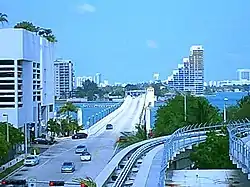Venetian Causeway
The Venetian Causeway crosses Biscayne Bay between Miami on the mainland and Miami Beach on a barrier island in the Miami metropolitan area. The man-made Venetian Islands and non-bridge portions of the causeway were created by materials which came from the dredging of the bay. The Venetian Causeway follows the original route of the Collins Bridge, a wooden 2.5 mi (4 km) long structure built in 1913 by John S. Collins and Carl G. Fisher which opened up the barrier island for unprecedented growth and development.
Venetian Causeway | |
|---|---|
 Venetian Causeway from Downtown Miami, east toward Miami Beach in 2002 | |
| Coordinates | 25°47′28″N 80°09′54″W |
| Crosses | Biscayne Bay |
| Locale | Miami to Miami Beach |
| Maintained by | MDX |
| Heritage status | NRHP (1989)[1] |
| Preceded by | Collins Bridge |
| Characteristics | |
| Design | Bascule |
| Total length | 2.8 miles (4.5 km) |
| Longest span | 0.4 miles (0.64 km) |
| History | |
| Designer | Harvey Stanley, Raymond Concrete Pile Co. |
| Opened | 1925 (original causeway & bridges) 1999 (current bridges) |
| Statistics | |
| Toll | $3.00[2] |
Venetian Causeway | |
| NRHP reference No. | 89000852[3] |
| Added to NRHP | July 13, 1989 |
| Location | |
The causeway has one toll plaza (administered by the Miami-Dade County Public Works department[4]) on Biscayne Island, the westernmost Venetian Island. The toll for an automobile is $3.00 (US).[5]
The causeway has two bascule bridges. At the Downtown/Western Beginning of the causeway travelers are greeted by two columns vertically saying "VENETIAN WAY" along with a sign indicating that there is a weight limit .
At the South Beach/Eastern Terminus, drivers must choose whether to go north onto Dade Boulevard or eastbound onto 17th Street to Ocean Drive, Collins Ave/A1A, Lincoln Road, City Hall, The Convention Center, Jackie Gleason Theater and the beach .
The Venetian Causeway was listed in the National Register of Historic Places in 1989.[6] It was re-dedicated in 1999 after the completion of a $29 million restoration and replacement project.[7]
In 2023 Miami-Dade County initiated a plan to replace the 11 original bridges along the causeway with higher structures.[8]
A popular use of the causeway is for exercising, including both jogging and bicycling.
See also
Gallery
 View of the Venetian Causeway and islands with South Beach in the background, as seen from the 1800 Club in Downtown Miami
View of the Venetian Causeway and islands with South Beach in the background, as seen from the 1800 Club in Downtown Miami.jpg.webp) The westernmost of the two drawbridges on the causeway, with its draw span opened for a boat
The westernmost of the two drawbridges on the causeway, with its draw span opened for a boat View from water level towards Miami Beach
View from water level towards Miami Beach View towards Miami Beach
View towards Miami Beach The Venetian Causeway viewed from former site of The Miami Herald
The Venetian Causeway viewed from former site of The Miami Herald Entrance to Venetian Causeway from Miami side
Entrance to Venetian Causeway from Miami side Column with Sign
Column with Sign Bridge detail, lamps and railing
Bridge detail, lamps and railing Entrance to Venetian Causeway with Columns view towards southeast
Entrance to Venetian Causeway with Columns view towards southeast
References
- "National Register Information System". National Register of Historic Places. National Park Service. March 15, 2006.
- "Venetian Causeway - Miami-Dade County".
- "National Register Information System". National Register of Historic Places. National Park Service. 2006-03-15. Archived from the original on 2010-05-27.
- Miami-Dade County Public Works department
- "Venetian Causeway - Miami-Dade County".
- "Venetian Causeway". Retrieved March 21, 2021.
- The City of Miami Beach Community Bridges The Past With The New Millennium Archived 2006-10-05 at the Wayback Machine, October 28, 1999
- Viglucci, Andres (March 5, 2023). "Eleven bridges on Miami's historic 1926 Venetian Causeway will be demolished, rebuilt". Miami Herald. Retrieved March 6, 2023.